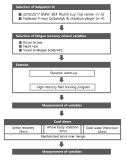
[Purpose] The purpose of this study was to examine the effect of recovery methods comparing with change ratio in Lactic acid(LA), Heart rate(HR), VAS(Visual analogue scale) on recovery patterns after field training(FT) in Korea National bobsleigh and skeleton players. [Methods] The tests were conducted for 3 times at a one-week interval as an experimental design within the same subjects(n=9), observed change ratio in LA, HR, VAS through applying Active recovery(AR), Whole body vibration(WBV) & Cold water immersion(CWI) after FT. [Results] The results were summarized as follows: The alteration of ratio in LA, HR, VAS decreased significantly after applying the three recovery patterns(p<.01). The difference between the groups showed that the reduction in lactic acid according to active recovery and whole-body vibration was higher than cold water immersion(p<.01). [Conclusion] In conclusion, although active recovery was more effective than static recovery, there was a significant effect of the three recovery methods in this study on reducing a fatigue in bobsleigh & skeleton players. Therefore, it would be considered to improve the performance of athletes when these methods apply for them depending on situations and environments.


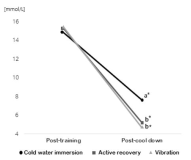
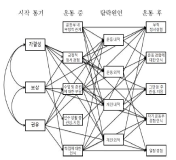
The purpose of this study is to explore the drop-out process of student-athletes and propose valuable policy ideas related to interscholastic sports. For this purpose, we surveyed 560 middle and high school drop-out student athlete's in 13 areas and finally 400 completed surveys were used for the study. To set the scales used for the study and test the reliability and validity of the scales, factor-analyses, Cronbach's alpha, and interfactor correlations were conducted using SPSS. For the main test, the paths analyses were carried out with AMOS program. As a result, we found two paths which had major effects on the drop-out process of student-athletes, self-efficacy path at the point of starting athletic career and negative relation path during athletic experiences. Based on these results, the following policy ideas were proposed. First, student-athletes should be able to join and leave athletic teams voluntarily. Second, the comfortable environments were provided to promote student-athletes' positive emotion toward athletic teams.

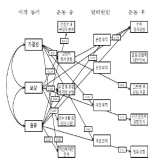



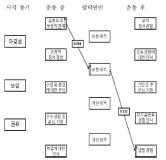
It has been known that β-alanine supplementation induce the increment of carnosine in vivo and was effective in delaying fatigue by buffering the hydrogen which was formed during exercise. This study was designed to investigate the effects of 4 weeks of β-alanine supplementation on physical fitness and blood lactate concentration in middle school soccer players. Nineteen middle school soccer players were randomly assigned to either one of two groups, i.e., β-alanine group (n=10) and placebo group (n=9). Subjects in β-alanine group consumed β-alanine 2 g/day during 1st and 2nd week, as well as 3 g/day during 3rd and 4th week, whereas subjects in placebo group consumed maltodextrin in the same manner. All subjects ate same menu and trained same amount at the same training camp during the intervention period. Body composition, aerobic capacity, anaerobic capacity, isokinetic function, and blood lactate concentration during maximal GXT were measured at pre- and post-test. Main results of the present test were as follows: 1) Fat mass and percent body fat decreased significantly in β-alanine group. 2) No significant changes were found in variables related to aerobic capacity in both groups. 3) Average power increased significantly in β-alanine group. 4) Isokinetic muscular endurance increased significantly in β-alanine group. 5) Blood lactate concentration did not change in eithet group; however, blood lactate concentration immediately after maximal GXT in β-alanine group tended to be increased more than placebo group. It was concluded that β-alanine supplementation would have positive effects for improvement of body composition, anaerobic capacity, and muscular endurance in middle school soccer players.
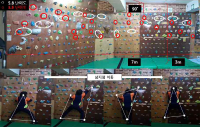
[Purpose] The study was designed to examine the effects of a 10-week sports climbing training on body composition and surrogate indices of major lifestyle disease in obese elderly women. [Methods] Twenty elderly women, whose percent body fat was over 35%, were randomly assigned into one of two groups, i.e., sports climbing training group (TR: n=10) and control group (CON: n=10). The subjects in TR completed sports climbing training program with 5.8 and 5.9 of difficulty, at 11-13 of ratings of perceived exertion (RPE), 60 min/session, three sessions/wk for 10 weeks. Independent variables regarding body composition and major lifestyle disease, i.e., hypertension, dyslipidemia, and atherosclerosis, were measured and compared between two groups as well as between two tests simultaneously using a repeated two-way ANOVA. [Results] Regarding physique and body composition, there were significant interactions between group and test in body weight, body mass index, fat mass, and percent body fat. These variables decreased significantly in TR. 2) Regarding indices of hypertension, systolic blood pressure, diastolic blood pressure, mean arterial pressure, and pulse pressure decreased significantly in TR. Regarding indices of dyslipidemia, triglyceride decreased significantly in TR. Regarding indices of atherosclerosis, TG/HDL-C ratio decreased significantly in TR. [Conclusions] It was concluded that the 10-week sports climbing training would be beneficial for reduction of body fat despite its’ influence on fat-free mass was limited, and would also contribute on improving surrogate indices of hypertension, dyslipidemia, and atherosclerosis in obese elderly women. Future research investigating the effects of various period, intensity, duration, and frequency of sports climbing training would be warranted.

Purpose The purpose of this study is to investigate the factors for setting proper training duration of frequency that can guarantee the student athletes' right to study and performance, and to derive the ranks of setting proper training duration of frequency of student athletes by school level. Consequently, to provide basic data for the development of training guidelines for the growth period of Korean student athletes. Methods Delphi and Analytic Hierarchical Process(AHP) techniques were used. The Delphi survey was conducted in three phases, and collected data through Delphi survey were computed by SPSS win ver. 22.0 and Excel, using the mean, standard deviation, median, and coefficient of variation. Using the AHP technique, we classified the factors for setting proper training duration of frequency derived through Delphi survey, and calculated the importance by using Microsoft Excel 2010. Conclusion First, elementary students should be guaranteed regular class participation, have basic after school training, and be provided with adequate rest so that they do not lose interest in the exercise. Second, middle school students are required to decide whether to continue exercise based on their ability to exercise and abundant experience. Therefore, when abandoning the exercise, students should be able to faithfully carry out their academic performance. Third, high school students are directly related to college entrance and employment, so they have to concentrate on performance rather than on academic performance.
PURPOSE This study analyzed the difference in lower extremity joint angle and shock absorption patterns at the point of maximum ground reaction force during single-leg drop landing with or without anterior cruciate ligament reconstruction (ACLR). METHODS Forty adult males were recruited for this study, with 19 in the ACLR group (age: 20.52±1.43years, height: 179.26±5.18cm, weight: 74.91±6.29kg) and 21 in the control group (age: 21.42±1.61years, height: 174.97±6.83cm, weight: 69.27±7.56kg). Participants performed single-leg landings on a 30cm tall box. An independent sample t-test was used to analyze the difference in kinetics variables at the point of maximum ground reaction force upon landing, with significance set at p=0.05. RESULTS The lower limb joint angle showed significant differences in hip flexion, hip abduction, knee flexion, and knee valgus (p<0.05) between groups. There was no significant difference between the groups in terms of the results of kinetics variables during single-leg landing (maximum ground reaction force, lower extremity stiffness, and shock absorption time). CONCLUSIONS The ACLR group showed a clear difference in kinematics compared to the control group, but no significant difference in kinetic results was found. The two groups compensated for the same impact with different movements, though movements in the ACLR group may increase the risk of ACL re-injury. Those with ACLR should strive to reduce the risk of re-injury by training to use correct movements.
PURPOSE This study aimed to investigate the effect of an ankle strap on kinetic variables of the lower limb during forward jump landing. METHODS Twelve healthy adult men (mean age, 23.58±2.22 years; mean height, 177.83±5.37 cm; mean weight, 75.00±7.72 kg) participated. The participants stood barefoot on both legs at a horizontal distance of 40% of their body height from the center of the force plate, then jumped forward and landed on the force plate with their dominant or non-dominant leg over a 30-cm hurdle while wearing or not wearing an ankle strap. Joint angle, peak vertical force, loading rate, and leg stiffness were calculated. Paired t-test and repeated-measures two-way analysis of variance with Bonferroni’s post hoc tests were used to compare the characteristics of both lower limbs and the effect of wearing an ankle strap. The significance level was α < .05 RESULTS Our results showed significant differences in kinematic variables between the dominant and non-dominant legs without the ankle strap. With the ankle strap, the inversion angles at the ankle joints of both lower extremities were significantly decreased, and an interaction effect between both legs and the ankle strap occurred in the internal rotation angle of the ankle joint. Kinetic variables did not differ significantly. CONCLUSIONS The ankle strap did not completely compensate for ankle instability in the non-dominant leg, but it significantly reduced the angle of internal rotation at the ankle joint. Thus, we recommend that correct wearing of the ankle strap in sports since it reduces the possibility of lateral ankle sprains to some extent.

Purpose The purpose of this study was to investigate the effects of low-intensity resistance training with blood flow restriction on serum VEGF, bone markers and bone mineral density in elderly women. Methods The subjects were divided into three groups: low-intensity resistance training with blood flow restriction(BFR-LRT, n=8); high intensity resistance training(HRT, n=8); low- intensity resistance training (LRT, n=5). Both the BFR-LRT and LRT groups worked out knee extension and leg curl exercises at 20% of each estimated one-repetition maximum(1RM) and HRT group worked out knee extension and leg curl exercises at 70% of each estimated 1RM 3 days per week for 12 weeks. Results As a result after 12 weeks, serum VEGF level have increased significantly among BFR-LRT group compared to HRT and LRT groups. Serum Bone ALP level have increased significantly among BFR-LRT and HRT groups compared to LRT group. Calcaneus BMD have increased significantly among BFR-LRT and HRT groups compared to LRT group. Conclusions In conclusion, despite using low-intensity load, BFR-LRT is a efficient training alternative to HRT for improving bone metabolism in older women.

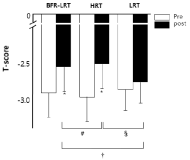
This study was designed to examine the effects of 12 weeks of resistance exercise training on physique, body composition, insulin resistance, and blood lipid profiles in 20s normal weight obese females. Sixteen females were randomized into one of following two groups: resistance training group (RT group; n=8) and control group (CON group; n=8). Subjects in RT group completed 12 weeks of resistance exercise training for three times/wk, and subjects in CON group were asked to maintain their normal life pattern during the same intervention period. Data were analyzed using two-way repeated measures ANOVA with post hoc test. Main results of the present study were as follows: 1) Body weight, BMI, waist circumference, hip circumference, WHR, and WHtR decreased significantly in RT group. 2) All variables regarding body composition did not change in both groups; however, fat mass was tended to decrease more in RT group than CON group. 3) Fasting plasma glucose decreased significantly in both groups, whereas other variables regarding insulin resistance did not change significantly in both groups. 4) All variables regarding blood lipids did not change significantly in both groups. Results indicate that 12 weeks of resistance exercise training was beneficial in physique and body composition; however, it was not beneficial in insulin resistance and blood lipid profiles in 20s normal weight obese females. Future research including normal weight obese subjects with higher age would be warranted to elucidate more clearly the effects of resistance exercise training on metabolic status.
PURPOSE This study aimed to investigate the effects of an 8-week unstable surface Pilates training on physical fitness, abdominal muscle thickness, lumbar isokinetic muscle function, and pain in women aged 30–40 who are living a sedentary lifestyle and experiencing nonspecific low back pain. METHODS The training group (TR, n = 15) performed Pilates using small apparatuses on an unstable surface for 50 min/session, three sessions per week for 8 weeks, whereas the control group (n = 13) maintained their usual living pattern during the same intervention period. RESULTS 1) The body weight, body mass index, percent body fat, and fat mass decreased significantly in the TR, 2) whereas the hand grip strength, trunk extension, sit-andreach, and modified Schober test scores improved significantly. 3) The thickness of the external oblique, internal oblique, and transversus abdominis increased significantly in the TR. 4) Lumbar isokinetic flexor strength per body weight increased significantly in the TR. The endurance and endurance per body weight of the lumbar isokinetic extensor and lumbar isokinetic flexor also significantly increased in the TR. 5) The Korean Oswestry disability index (KODI) and the visual analog scale (VAS) score decreased significantly in the TR. 6) Significant negative correlations were found between the change rates in the KODI and nondominant hand grip strength, external oblique thickness, transversus abdominis thickness, and lumbar isokinetic extensor endurance. A significant negative correlation was found between the change rates in the VAS score and external oblique thickness. CONCLUSIONS The results revealed that the 8-week unstable surface Pilates training was beneficial in improving physical fitness, abdominal muscle thickness, lumbar isokinetic muscle function, disabilityindex, and pain levels in women aged 30–40 years who were having a sedentary lifestyle and experiencing nonspecific low back pain.